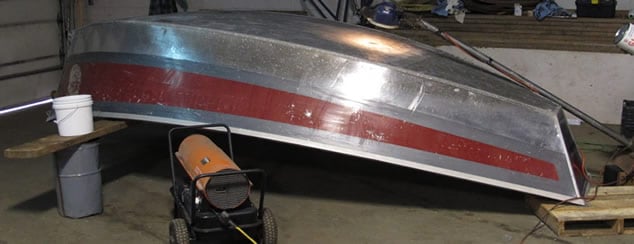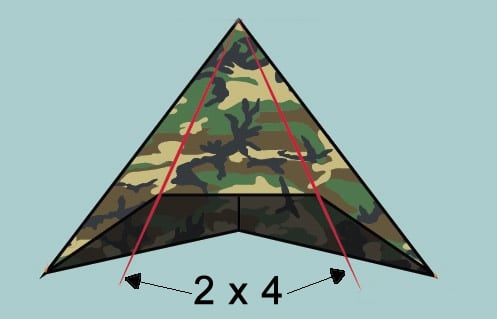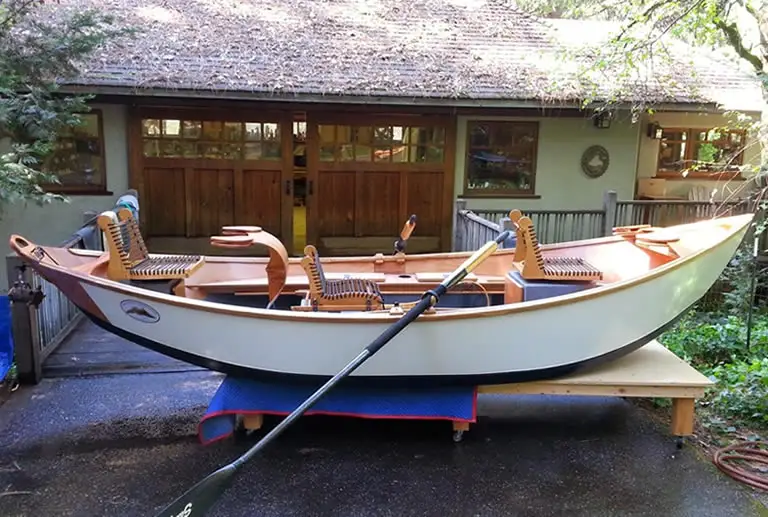Ideally a drift boat should be stored inside a building or under a canopy. If a drift boat is stored outdoors then it should always be covered to protect it from being filled with rain water. Be sure to flip the boat over so the open deck is facing the ground and elevate the boat off the ground, then cover the entire boat with an appropriate boat cover.
Storing drift boats
Because a drift boat has evolved from the humble open water fishing dory, traditional drift boats were made of wood thus being bulkier and heavier than other small inland boats, like a Jon boat for example. However modern drift boats are available in both fiberglass and aluminum and are considerably lighter than their dory ancestors. Even homemade wooden drift boats are usually constructed from lightweight plywood.
A drift boat is somewhat similar to a skiff in size and width however it is considerably lighter. It also has similarities with a traditional wooden rowboat but again is significantly lighter. The weight of a drift boat would be more akin to a Jon boat and therefore we can use similar storage techniques for a drift boat that apply to a Jon boat.
Let’s look at some of these ways to store your drift boat now.
Storing indoors
If possible a drift boat should be stored in an outbuilding. Storing your boat indoors will eliminate all the possible problems that can arise from storing your boat outside (problems we will cover later).
Storing your drift boat in a building is by far the easiest way to protect it. If you have the available space simply pull the boat and its trailer into the building and cover it so it doesn’t gather dust and spiders.
If no outbuilding is available then consider erecting a simple boat shelter. Building your own boat shelter is very easy and a quick project that most “outdoors people” will find not just easy but also enjoyable.
Below is a video showing you how to build a basic shelter for your drift boat.
How to build your own basic drift boat shelter (video)
Storing outdoors
Sometimes storing your drift boat indoors, or building your own boat shelter, are just not viable options. The good news is that although storing your drift boat indoors or under shelter is better, storing it outdoors is not a problem as long as you take the proper precautions.
Just be aware that when you only have space available outdoors for storage there are key steps you must take to protect your boat. Failure to take these steps will cost you in the long run because your boat will suffer damage when left alone to deal with the elements.
It all starts with where you store your boat.
Where to store a drift boat outdoors
If you have to store your drift boat outdoors then you should try to store it in an open area away from trees with overhanging branches.
Wet leaves will stick to your boat and the tannins in leaves can cause staining. Even the boaty is covered the decaying matter can eat into the boat cover and cause it to allow water to get through.
If you have no other option than to keep the boat close to falling leaves be sure to clear any debris off your boat and cover at least once per week and more often if there is frequent rainfall.
Summer drift boat storage
In the summer months the storing of your drift will probably just mean leaving the boat on its trailer outdoors. An adequately cut boat cover will be more than enough to protect the boat during those summer periods when it is not in the water.
In summer, when left outdoors, don’t be tempted to leave the boat uncovered.
Summer rain causes just as much problems as winter rain just in smaller amounts. Although it probably doesn’t rain as much in your locality in the summer it probably rains sometimes.
If you live in a dry climate and it doesn’t rain at all, or very little, don’t think your boat is safe uncovered either; there is still the wind to contend with. Wind, even in summer (and especially is dry climates), can throw debris against your boat damaging the paintwork and moving parts like oarlock pins.
The simple rule-of-thumb is to cover your boat regardless of how long, or how short, of a time it is out of the water!
Winter drift boat storage
Winter poses more of a problem for drift boat owners, who have to leave their boats outdoors, than summer does. Obviously winter rain and wind can be more damaging, and come in greater quantities, during the colder months. So merely leaving your boat with only a boat cover for protection in the winter just isn’t going to be enough to protect it.
Although modern drift boats are made from aluminum or fiberglass they are still at the mercy of the elements. So take the following precautions if you want to protect your boat during the winter.
Flip the drift boat over and cover
Depending where you live in the country you may have rain and/or driving wind in the winter. It is unlikely you have neither though. So you must take steps to protect your expensive drift boat from the elements during the winter months.
A simple boat cover is not enough to protect a drift boat that is kept outdoors in the winter.
The open deck of a drift boat means it will quickly fill up with rain water or snow if it is not covered. As I already stated a simple boat cover is not enough to protect the boat if heavy rain or snow falls.
Why is this?
Hanging a boat cover over a drift boat in heavy rain, and especially in snow, will likely lead to boat damage due to the weight being placed on the cover – and thus key points of the boat where the cover rests. There is an easy fix for this though.
The best way to protect your boat for potential water or snow fill is to flip the boat over. This may involve removing the seats from the boat first and storing them separately – indoors.
Place some blocks of wood, or pallets on the ground to hold the boat and keep it from having direct contact with the ground. Ensure that the blocks or pallets that will hold the stern of the boat are higher off the ground than the blocks that will hold the bow of the boat (or vice versa).
Then flip the drift boat over so the open deck is facing the ground and the bottom is facing up and place the boat on the blocks/pallets. Doin this not only totally eliminates the problem of water-fill from heavy rain but it ensures that any water that falls on the boat cover will be channeled down towards the ground and will not sit on the boat cover. It also ensures ground damp does not penetrate the boat.
As a drift boat is lightweight it should not be a problem to lift the boat and flip it over (with some help of course).

Protecting the boat from heavy rain and snow
If you do get any amount of snow, or very heavy rain, then you may want to place a couple of 2 x 4’s across the boat under the cover in a pyramid type shape.
This will minimize the stretch and weight on the cover when snow starts to lie on the ground.
This type of makeshift canopy also allows the water from heavy rainfall to run down the sides of the cover.

What happens when you don’t use a cover (video)
This is what happens when you leave a drift boat outdoors, right-side-up and with no cover! Get a proper drift boat cover.
Don’t forget to cover the boat trailer
Be sure to also cover your boat trailer.
Many boat owners go to great lengths to ensure every inch of their boat is covered and protected and completely forget about the trailer.
Boat trailers are made from metal with metal fittings and so they rust easily. The last thing you want to happen is damage occurring to your pristine drift boat because of a failure in the integrity of your boat trailer!
Cover the boat trailer to protect it from the elements as well.
This also protects your boat from future damage due to trailer failure.
If you live in a climate that gets very cold winters and lots of snow and ice you should also consider protecting the tires of your boat trailer as well. Tires left in cold and wet environments will fail in the summer when you least expect them to causing potential damage to both the trailer and your drift boat.
Take a few pieces of marine grade plywood and cut them to fit just under the wheel wells. This will help to protect the tires from the effects of snow and ice. Freezing temperatures and damp snow and ice, in conjunction with a lack of driving tends to check the rubber on the tires.

